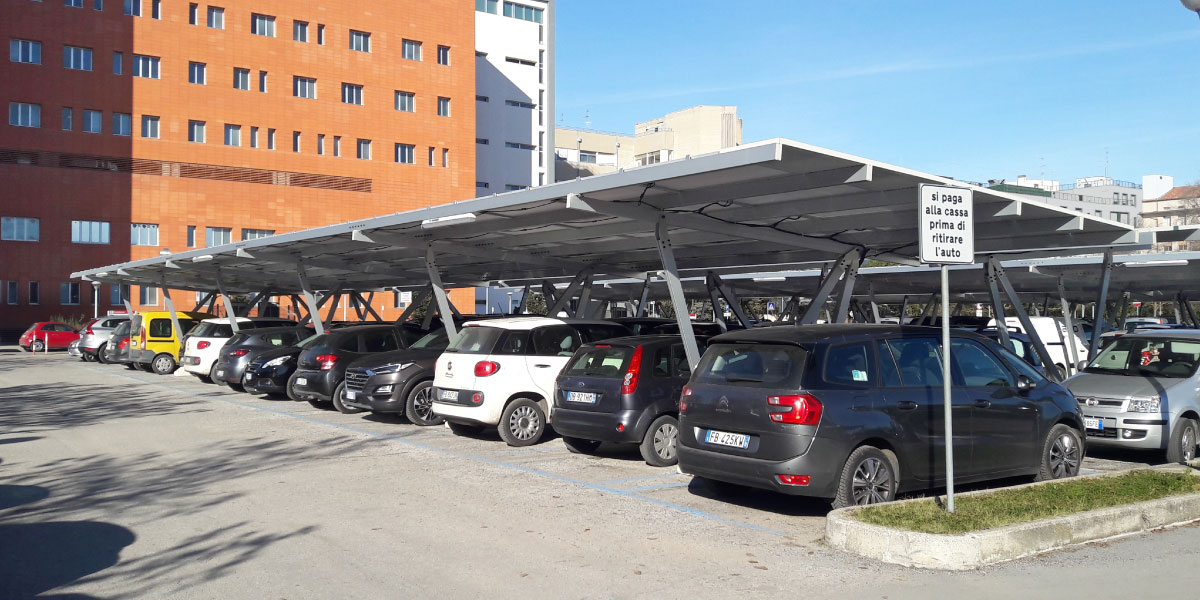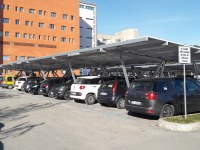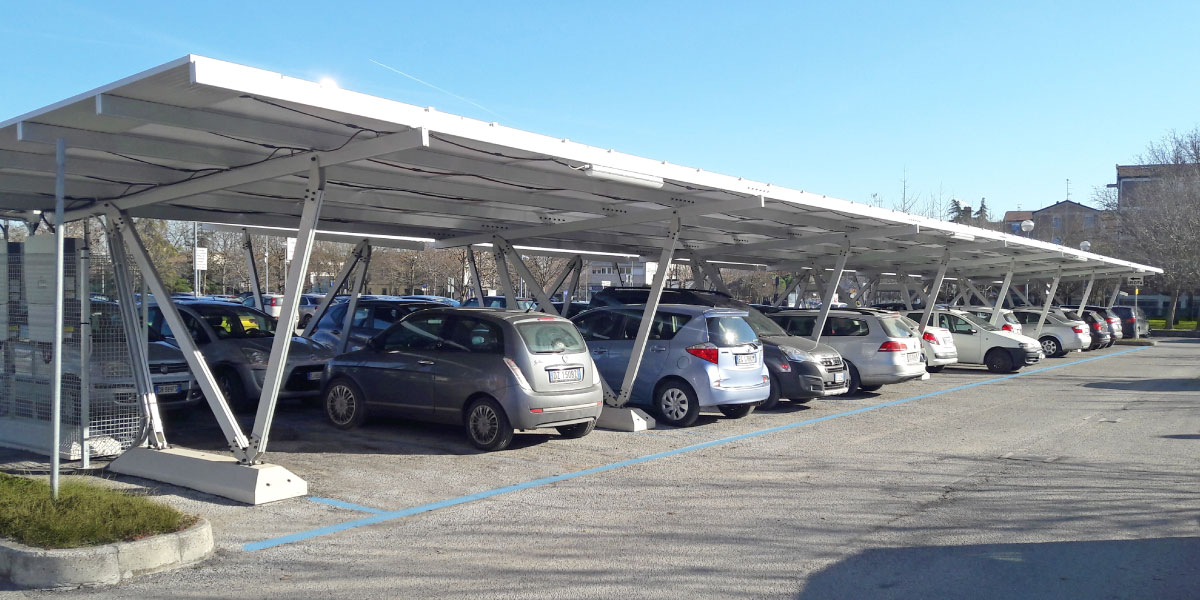The public hospital of Ravenna chooses 4 solar carports for its solar energy self-consumption
Today, a photovoltaic system is convenient even without the government incentives, especially if it is used for self-consumption.
It is estimated that in the Italian industrial sector, self-consumption has already reached 20% of the total energy produced through photovoltaic systems and this percentage is expected to grow exponentially.
We are currently in the middle of a transition towards renewable energy sources, carried out mainly by forward-thinking companies that have understood the real advantages of installing a photovoltaic system. However, the industrial sector is not the only one who is carrying this change forward.
A growing number of municipalities are proving virtuous and are ready to choose energy supply systems capable of significantly reducing public spending.
This is the case of the Azienda Unità Sanitaria Locale (Local Health Unit) of Romagna, which has installed 4 solar carports covering more than 100 parking spaces at the Santa Maria delle Croci Hospital in Ravenna and thus producing a total of 200 kW for self-consumption.

A photovoltaic system on a shelter is more powerful and maintenance is easier!
Request a personalized quote
The contract was won by Tecno Allarmi Sistemi S.r.l. Ravenna, a company that boasts over twenty years of experience in design and implementation of electronic security systems, particularly in the field of healthcare.
The company has numerous orders involving hospital facilities, such as the S. Maria Nuova Hospital of Reggio Emilia, "Ospedale Maggiore" of Bologna, the Bellaria Hospital, the Sant’Orsola-Malpighi Polyclinic of Bologna, and many others.
As is often the case, hospitals are equipped with large car parks to accommodate their customers' cars.
By installing photovoltaic carports, these spaces can easily be converted into sources of renewable energy.
THE PROJECT
"Installing of a photovoltaic system on a canopy has several advantages over a system on the roof. In fact, the operations of monitoring, maintenance, and cleaning of the panels - essential to ensure maximum efficiency - are much easier to perform because the panels are within reach.
Furthermore, the panels receive plenty of ventilation - an ideal condition for their proper operation. And finally, you don't run the risk of damaging the waterproofing layers of the roof while securing the panel supports.
For these reasons, it was decided to install photovoltaic carports", explains Michele Spedaluzzi, technical director of the Ravenna-based company.
"In the specific case of a hospital like this one, it is vital that the car park is free and available, which is why we couldn't obstruct these spaces by setting up a construction site.
As a result, we decided to involve in this project the Giulio Barbieri S.r.l. company from Ferrara - the solar carports they produce are equipped with reinforced concrete bases that go directly in the ground without requiring the construction of foundations.
In this way, we were able to install two carports at a time, without stopping the customers from using the parking lot, and the whole project was carried out without any complications in just 3 weeks.
As I mentioned already, these structures are made of aluminium and, therefore, they are more expensive than iron structures. However, we chose them because aluminium naturally produces a protective oxide and does not require expensive and troublesome maintenance".
In fact, this project is an integral part of a wider renovation plan that will involve the hospital premises and that began with the inauguration of the new Neurology Ward in May 2018. "At present, a substantial design process is underway to upgrade the operating theatres and the pertinent equipment. A big part of this process was the adaptation of the structure's energetic supply with the installation of the photovoltaic system, which made the hospital more environmentally friendly. The various projects concern the relocation of all the operating blocks, currently located all around the building, to the new operating area of the Emergency and Admission Department (DEA), which will significantly improve the internal logistics and patient care. The obstetricians' operating activity, on the other hand, will be located in yet another operating block, which will be developed at the recently built Labour and Delivery area. The total funding amounts to over € 5,200,000 funded by the Region and national resources", says the director of Technical Operations of AUSL Romagna, Enrico Sabatini. "After the construction of the DEA, we carry on improving the entire hospital and we are working on the creation of an actual health citadel in Ravenna".
IMPROVEMENT OF THE ORGANIZATIONAL STRUCTURE OF THE HOSPITAL
"Building renovation has already led to a first improvement in the organisational structure: the operating unit offers a Neurophysiology service that performs approximately 35,000 services per year on about 8,000 patients, specialising in epilepsy research", says the head physician Pietro Querzani.
"As for outpatient activities, we follow about 500 patients with epilepsy, 300 patients with multiple sclerosis, and 200 patients with movement disorders and neuromuscular diseases such as amyotrophic lateral sclerosis (ALS). Finally, a third level outpatient clinic is available for approximately 700 patients suffering from headaches. I'm happy" concluded the head physician "because our current hospital premises date back to 1969" .
The quality of the building is one of the determining factors for the quality of the health service provided and the type of energy support is an essential component that strongly affects the structure's maintenance costs.
The decision to install the solar carports to generate energy that can be used directly within the structure shows how the AUSL of Romagna continues to protect patients and citizens in the first place, by carrying out practical interventions aimed at optimising resources and, therefore, having regard for the taxpayers.
The hospital of Ravenna is not the only case of virtuous public administration: the Santa Maria della Misericordia Hospital in Perugia has also installed a photovoltaic system for self-consumption, on the roof, however, for a total of 4,500 square meters, an annual production of about 250 megawatts and a cut in atmospheric emissions equal to 4825 tons/year.
Some of the other hospitals that have embraced the energy transition with the installation of photovoltaic systems are the hospital of Chivasso, in the province of Turin, the hospital of ICP Bassini in the province of Milan, the hospital of Cortona, in the province of Arezzo, the San Giovanni Hospital in Rome and the hospital of Grosseto.


